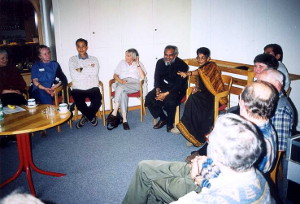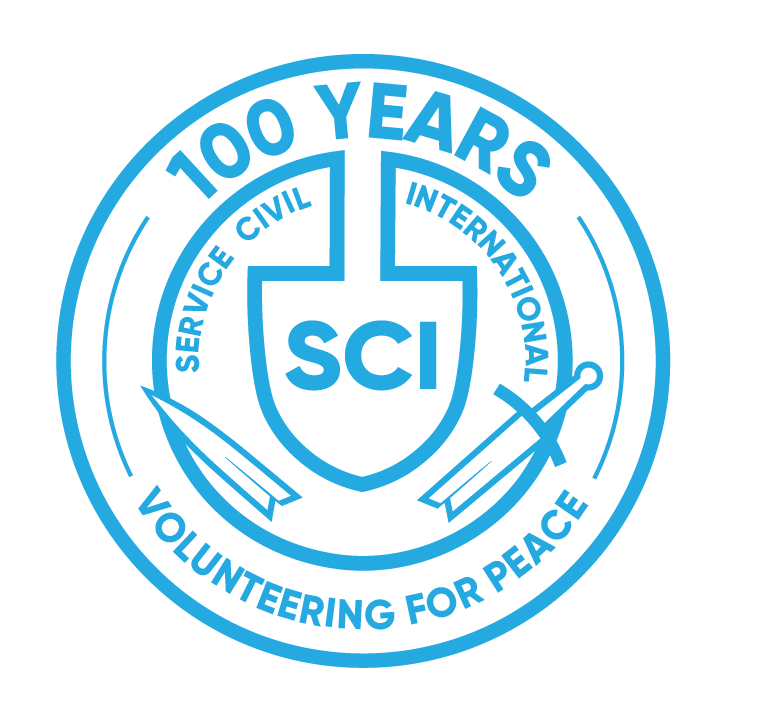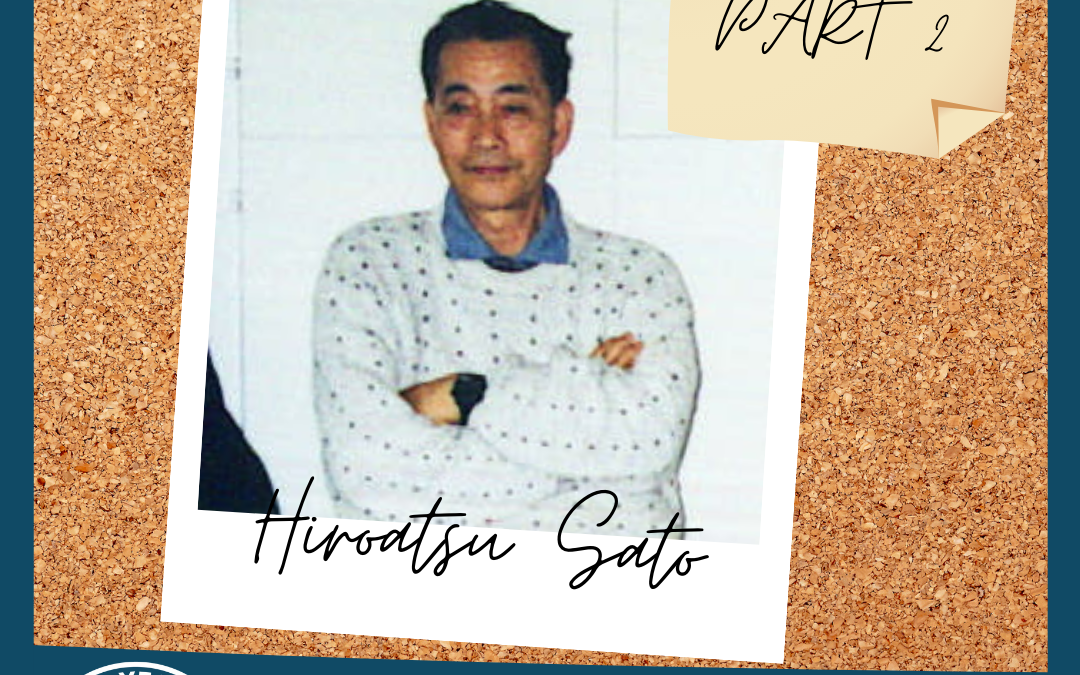SCI in Japan
From Phyllis, his wife’s perspective
Four months after he returned to Japan in 1958 Sato organized the first small workcamp, with only Japanese participants, on a small island in Tokyo Bay, an overnight boat trip from Yokohama. The National Self-Defense Force (an army was prohibited in the Constitution, but a Self-Defense Force was permitted) selected an uninhabited area of the island to build a missile testing site. Islanders were deeply divided, and various political parties sent in outside organizers for protests. Sato found that child care while women worked in the fields was an issue, and the group collaborated in getting land for a kindergarten, and in subsequent workcamps worked on building a playground and assisting. Families from both sides of the divide were engaged in the venture and cooperation cooled tempers. Students who attended were impressed by this constructive, practical activity and formed the core of later work in Japan. In September after that workcamp, I came to study Japanese and we married in Tokyo.
Sato continued to organize a variety of workcamps, especially Leadership Training camps, and even wrote a leader’s handbook, later translated into English, so there was a pool of leaders. Taking from the French Branch’s example of relief work, after an earthquake in northern Japan, SCIers raised money at railway stations and sent a team to help. The first Asian Secretary, Devinder Das Chopra, visited the Group in 1961 after the birth of our second daughter and subsequently arranged for Indian MTVs to come – Atma Singh and Kurian Paul were among those and we recruited among American students in Japan, thus gradually internationalizing the camps. Around this time students from South Korea came to participate in Japanese workcamps, and eventually, these experienced ones began to organize activities in South Korea. Valli Chari, from the Asian Secretariat, also visited in 1963 and stimulated interest, promoting an exchange of volunteers.
During this period our home was the gathering place and contact point, even after Japan attained Branch status – 1962 I think. With a growing family, we supported ourselves by teaching English in our home, making subtitles for “B” Japanese movies exported to Hong Kong, and translating scripts for dubbing American TV programs. We could set our own schedule, and Sato was able to go to workcamps and help the new Secretary, Fumi Ono, who came daily to our house. Increasingly, LTVs who had finished their time in India took the MM (Messargeries Maritime) boat line on to Yokohama – like Thedi von Fellenberg, Elizabeth Crook, Cathy Hambridge Peel, and Ann Smith Kobayashi (from Thailand).
Asian Secretary, 1965-1968
Once Devinder and Valli decided to move on from the Asian Secretariat, Sato was approached. A month after our third child was born, in 1964, he set off by boat to Vladivostok, across Siberia to France for the November International Committee Meeting (ICM) where his appointment was finalized and he met the International Secretary, Ralph Hegnauer. Because of tensions between India and Pakistan and Ceylon, visas to travel to each other’s country were difficult so the ICM asked Sato to explore setting up an office outside of India. Since Devinder had made good contacts and initiated workcamps in Malaysia, that seemed a promising location. First, Sato returned by boat, via India for a handover of important information, and stopped off in Taiwan to explore some contacts there. For the next six months, the office operated out of our home, as we awaited a response from the government in Kuala Lumpur for residence visas. Finally, a letter came suggesting that we come on a temporary visa and pursue it in person. We disembarked in Singapore on the day it separated from Malaysia, in 1965, with confused custom officials finally accepting our Malaysian tourist visas.
Thanks to a grant from an American foundation to promote the exchange of volunteers within Asia, there were resources to stimulate activities. It also meant that Sato was on the road (strictly speaking air as our toddler would point to a plane and say ‘Dada’ from seeing him off on planes) half of the year. There was promising activity in Thailand, Nepal, and Ceylon, with cyclone relief work in East Pakistan, in addition to all the usual SCI meetings. Fortunately, Masahiro Shintani was appointed Assistant Asian Secretary in December 1966, spreading out the office work and travel. Just 3 months after his arrival, the Malaysian cabinet finally made a decision not to permit the Asian Secretariat to establish an office in Malaysia. They wanted SCI to disavow work with conscientious objectors because they were concerned that pacificism meant communism (this was not long after the British had quelled a communist insurgency there) and questioned Sato’s travel to South Vietnam where he explored work with Buddhist groups. As an American I could enter Singapore without a visa so was sent to talk with Singapore officials. Being a duty-free port, they had no problems with SCI and immediately granted us permission. The same day I found a lovely old house on stilts, with servants quarters that could be used for an office, about 10 miles west of city center. The office was relocated within two weeks and proved much more accessible. Singapore was a port of call for the Messargeries Maritimes boats so volunteers could easily drop in.
After visiting so many SCI long-term projects, Sato began to question their inherent structure, with its built-in turnover creating a distance from the local community. An alternative formulated in his mind for an agricultural project. He envisioned permanently settling on the project site in the role of a “good neighbor” to model new agricultural techniques so that development would occur organically. Resigning in early 1968, succeeded by Navam Appadurai, with Masahiro remaining in Singapore, Sato went to India in late 1968.
Visionville, 1968-1977
Sato found land 17 miles from Bangalore and Visionville was formed. He and other SCI LTVs established an Asian Regional Training Center at the farm – a big name for a program that gave orientation to incoming and outgoing M/LTVs and hosted workcamps. We were also fortunate to have LTVs working with us on the farm plus the initial assistance of Kurian Paul, and looked forward to the day when two other couples, the Seshans, and Parashiva Murthy plus family, were able to join in a co-operative venture.
We started from scratch: having a temporary house built, drilling a well, making irrigation facilities, bringing in electricity, etc. Aided by the fruits of a steep learning curve, the overgrazed, eroded land was gradually transformed into a working enterprise. Over time it seemed that trust was being built, and small effects were seen, validating Visionville’s initial premise. However, other forces were working under the surface as the traditional power structure began to feel threatened. Month after month passing by the unfinished one-room school in a nearby village, Sato inquired about the hold-up. He was told the money had run out – actually had been siphoned off by a corrupt leader. Sato proposed to provide labor through a workcamp if the leader would raise some money for their expenses. It was completed but also it had offended a powerful person. Rumors were planted that Visionville operated a counterfeiting press and that with the steady stream of foreigners observed, it was a CIA outpost. That fed into the paranoia caused during the Emergency declared by Indira Gandhi. The policy was to deny visas to non-government sponsored individuals, especially those living in village areas so we got a letter telling us to leave with only what we could carry.
After denial of an appeal to the Home Ministry, we left Visionville in late November of 1976. As we prepared to board our plane in Bangalore, on the other side of the glass partition, the Parashiva Murthy family was walking to the baggage claim. Their move from Canada to India had been in the works for over three years, and they decided to come despite our impending departure. Martin and Juliet Pierce were the ‘Visionville liaison team’ and transmitted the wheres and whys of daily operations. Subsequently, the whole property was sold to a poultry factory which later went bankrupt and now the land has been reclaimed by bushes.
Sato looked back on Visionville as a rich learning experience and felt that the ‘tuition’ paid was well worthwhile, infinitely better than university. Aside from practical learning, and village customs, living and working together with so many people willing to question one’s own and other’s foibles created a rare atmosphere. There was no place to hide or disappear. Crops and livestock are relentless taskmasters. In retrospect, being in touch with nature’s cycles, yet stimulated by other seekers, meant we were provided an environment never replicated in urban settings.
Before his death, Sato also likened the rise and fall of Visionville, as well as many other things he had been passionate about, to the Hindu concept of ‘lila’. The ‘play of life’ reflected in building sandcastles at the seashore that are wiped out by the incoming tide and built again the next day. The thing that remained, however, was his feeling of connectedness to other people. Some were brief encounters, others were paths that crossed again and again. We all enrich each other’s lives in ways unbeknownst to us, and a lifelong association with SCI has been a good catalyst for that phenomenon.
Conclusions

Sato, Phyllis, Muzammil and Valli in Herzberg 1998
Being accurate as to how Sato distilled his long SCI involvement is a challenge because either they are intertwined with mine or the echoes of what he repeated over and over until it finally became mine. As trite as it may sound, the ‘Deeds, not words’ became our organizing principle and has remained a solid lifelong principle. The mechanism of a workcamp also has not lost its appeal as a tool of bringing people together to do something practical. Contrary to those who said that projects were hard to find in a modernized society, Sato felt there was more need than ever. In the U.S. he led its first workcamp with a Navajo community and one in a Philadelphia ghetto with tense racial divides. With increasing polarization today, I know Sato would be sure to find a project to bring Muslims, Jews, and Christians together.
He remained fully committed to the reconciliation roots of early SCI, believing that working and sharing meals together in challenging conditions was vital in combating the propagandizing media that demonizes the ‘other’. Even if it is only a small number, the effect can gradually expand mirroring Pierre Cérésole’s dictum: “If it takes a thousand steps, begin the first one today”.
On an organizational level, Sato remained active as a member of the International Committee and International Executive Committee during various waves of issues. Sato, along with Valli, was a vocal critic of ‘Eurocentrism’ within SCI. This was manifested by its willingness to send large numbers of Europeans to Asia and Africa (because government grants were there) without receiving volunteers from those countries. A token exchange program was not enough in his opinion. He often faulted European branches for looking at the world through its own prism, rather than as an international body. He was very sensitive to unspoken assumptions of superiority or subtle paternalism that he felt lay just beneath the surface in attitudes towards Asia.
The principle of reconciliation
During the period when many SCI Branches and Commissions began taking what he saw as ‘sides’ and were looking at injustices caused by other countries rather than at the injustices in their own backyard; he emphasized the principle of reconciliation. Some called this being a ‘purist’, but Sato thought it was an immutable principle of SCI. He recognized that SCI needed to be forever evolving and adapting to changing conditions such as the move away from the initial ‘pick and shovel’ workcamps in the `30s to the work-study camps in the mid-`50s and long-term projects. However there were certain core principles that needed to be retained, or SCI’s reason to exist would dissolve into being a generic social gathering. A unique aspect of SCI that Sato found valuable was its national structure. The Secretaries and committees were from that country, so knew its customs and ways of doing things. Yet these national branches did cooperate. He used to contrast it with the Quaker Centers in India, Japan, or Singapore. Their members were nationals, but the head was usually British or American and followed their mother country’s structure. Initially, aid organizations followed this pattern, and he felt SCI had something to offer because its local staff had an intimate knowledge of local conditions.
As an individual Sato was forever marked in his formative years by how he had been lied to by politicians and by Japan’s defeat. In his last years, he said, however, that he was still hopelessly Japanese – in his training and culinary preferences. Yet he also felt that he was a citizen of the world and could be at home anywhere. His SCI involvement had become his new crucible.

